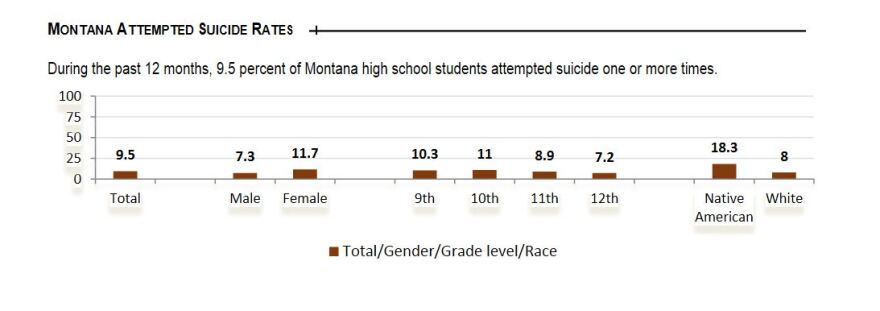During the last 12 months, almost 10 percent of Montana high school students attempted suicide one or more times. That’s according to a biannual youth risk behavior survey.
State lawmakers this year responded by requiring Montana’s 409 public school districts to draw up suicide prevention and response plans. A committee that met for the first time Wednesday will – as now mandated by law – develop a policy to ensure those districts follow through.
Tim Tharp, Deputy Superintendent of Montana’s Office of Public Instruction, says most already are.
"I know from my work with schools that they’re providing the instruction to their staff," Tharp says. "They’re providing training. They’re adopting best practices. This is our way to partner with the Legislature. They put this rule in place; how do we as an agency, how can we support the enforcement of this?
OPI’s Tharp says the Suicide Prevention and Response Rulemaking Committee will not dictate to school districts what should or should not be included in their locally-produced suicide prevention plans.
"It’s just to look at the language to put it into place that thou shall have these plans adopted, Tharp says."
Edward O'Brien: And the stick here would be tied to accreditation, correct?
"Yes sir, correct," Tharp says.

Kayla Jackson says that sends an unmistakable message. Jackson is Project Director for AASA, The School Superintendents Association, which represents about 1,300 American and Canadian school superintendents.
"Whereas accreditation is a big stick, I think it says that the state is very serious and committed to this work," Jackson says. "I think that sends a very clear message to the districts that this is something that’s important and they need to do it now."
Most members of the OPI’s 16-member committee that’s now developing a policy to ensure school districts have suicide prevention plans have school connections; counselors, teachers, trustees and parents of school kids. Montana’s Suicide Prevention Coordinator also has a seat at the table.
But only one member of the committee is Native American. Native youth are at the highest risk for suicide among all Montana’s population groups,
OPI Deputy Director Tim Tharp points out there, "Wasn’t a whole lot of competition in some of these areas. It’s not like we had 200 people to try to thin down and identify the group of 16. All we could go off of was people who were nominated or self-nominated. There was a process to invite people to be part of this. Based upon the people who applied or were nominated to be part of it, that is where the selections were made. Yes, it would have been nice to have some more Native input, but I have a lot of faith in the people that did get selected for this."
Kayla Jackson of the The Washington D.C.-based School Superintendents Association says suicide is now a national public health crisis and a major topic of conversation in education.
“Kids come to school now with all kinds of trauma and mental health disorders that I won’t say they didn’t have when I was in school in the '70s and '80s, but that are certainly, I think, exacerbated by the current environment that we live in. They bring those with them in that other backpack that we perhaps we can’t see,” Jackson says.
According to Jackson, that includes insecurity in the post 9/11 world, an inescapable social media landscape where bullies thrive, and ever-earlier diagnoses of mental and emotional disorders.
"Providers are overwhelmed by the number of young people who need their assistance and there’s just not enough providers in the pipeline," she says. "So if you move those reasons to a state like Montana, it’s understandable that we have a lot of kids who are isolated, not able to get into services and a lot of denial."
Montana’s suicide rate has ranked among the top five in the nation for decades. Contributing factors include easy access to firearms, social isolation and high drug and alcohol abuse rates. That’s why suicide prevention advocates say Montana schools must have plans ready to quickly help kids in trouble.
"Schools are a place that need to be for safety," says Montana Superintendent of Public Instruction, Elsie Arntzen. "That’s not just a school issue, it’s a community issue. The Legislature recognized in the last session that it is a state issue."
Once the committee that met Wednesday finishes its work, it will be up to the Board of Public Education to approve their suggestions for what should be required of local school district suicide prevention plans. The earliest anything could be implemented would be spring of next year.



